Vanilla
Inspired by the Philippe Conticini classic from LPDR
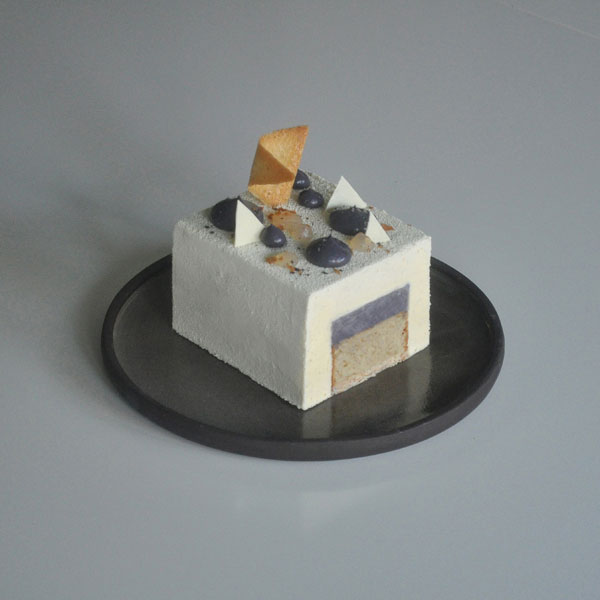
Grand Cru Vanille. Grand. Cru. Vanille.
If you've ever been to La Pâtisserie des Rêves in London or Paris you'll know what I mean. It's a completely unassuming cake, which you'd perhaps not look twice at given the treats under the cloches ... then you try it and you realise (as long as you actually like vanilla) that it's one of the greatest pieces of pâtisserie ever made. The real recipe, however, is notably absent from the LPDR book - probably because it's a closely guarded secret.
I've wanted to recreate it for years, and have commented many times to my Instagram buddy and pâtisserie genius Alvin about attempting it.
While re-creating it would be cool, I thought - you know, since LPDR's version is actually perfect - that wouldn't be wise as it would only cause disappointment. So, instead, I've re-imagined it. A bit.
I made this one for my mum's 72nd Birthday this week. The whole cake was polished off; good job the recipe makes two.
You can reduce the complexity by omitting the decorations if you prefer. My preference was to use a Silverwood adjustable cake tin for this (link in the ingredients section below) but you can easily adapt it if you have two 30cm tins that fit inside each other.
Ingredients (Makes 2 individual cakes, each serving 4 people. You'll also have left over salted tuilles and Feuilletine chocolate pieces to enjoy later)
For the Joconde layer
- 62g icing sugar
- 63g ground almonds
- 20g strong flour
- 80g whole eggs
- 14g unsalted butter
- 50g egg whites
- 15g caster sugar
- Optional - 100% proof vodka with a vanilla pod soaked inside for 2 weeks
For the Feuilletine layer
- 95g ground almonds
- 15g icing sugar
- 7g unsalted butter
- 60g white chocolate couverture
- 1/2 tsp fleur de sel
- 1 Vanilla pod
- 1/2 tsp Vanilla powder
- 35g feuilletine
For the black vanilla bavaroise
- 125g white chocolate couverture
- 125g full fat milk
- 30g egg yolks
- 15g caster sugar
- 190g whipping cream
- 3g gelatine (about 1 1/2 sheets)
- 1 tsp Vanilla powder
- 2 vanilla pods
- 1tsp black food colouring or activated charcoal
For the white vanilla bavaroise
- 250g white chocolate couverture
- 250g full fat milk
- 60g egg yolks
- 30g caster sugar
- 380g whipping cream
- 6g gelatine (about 1 1/2 sheets)
- 2 vanilla pods
For the white chocolate flocking
- 200g white chocolate couverture
- 140g cocoa butter
- 4 teaspoons of superwhite food whitener (optional)
For the fleur de sel tuiles (optional)
- 25g unsalted butter
- 40g egg white
- 55g caster sugar
- 25g double zero flour
- Pinch of vanilla powder
- Several pinches of fleur de sel
For the vanilla vodka fluid gel (optional)
- 110g soda water
- 25g caster sugar
- 15g vanilla vodka (I used 100% proof Stoli with a vanilla pod soaked inside for 2 weeks)
- 1/4 tsp vanilla powder
- 2g agar agar
To serve
- Vanilla powder
- Fleur de sel
- Feuilletine
Equipment required
- Cake frame with adjustable panels (Silverwood does a good one)
- Thermometer
- Piping bags and nozzles for plating
- Silicone mat
- Stand mixer
- Food processor
- Sieve
- Stick blender
- Spray gun
Make the Feuilletine layer
Put the ground almonds and icing sugar in your food processor and leave running until the oils of the nuts begin to be released and you get an almond paste. This will take around 10 minutes.Split and scrape out the seeds from the vanilla pod and put these, the split pod, vanilla powder, salt, butter and white chocolate into a heatproof bowl and melt over a simmering pot of water.
When completely melted, remove the pod and combine with the ground almond paste.
Fold in the feuilletine, then pour out onto some cling film. Cover with a second layer of cling, then push down with a rolling pin - it should be thick enough to roll out, but leave to cool a little if it's too soft.
Roll out to about 1/4 cm thick - it should be at least 30cm long, and 5 to 6 cm wide (see next section). Place in the fridge while you continue.
Make the Joconde
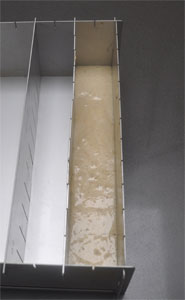 Pre-heat your oven to 200°C.
Pre-heat your oven to 200°C.
Prepare your tin - if you've got a silverwood, you want to set it so you have it set at 2 notches wide, as shown here to the right. If not, a tray tha'ts 5 to 6 cm wide by 30 cm long will do. Spray it with bake spray, and line the bottom with greaseproof paper.
Put the eggs, icing sugar, flour and ground almonds in the bowl of your stand mixer, and whip up with the whisk attachment for about 10 minutes.
While this is running, melt the butter then let it cool. After 10 minutes are up, slowly pour the butter into the running mixer.
Put the egg whites into a clean bowl, and whip until medium firm. Shower in the caster sugar, then whip to stiff peaks.
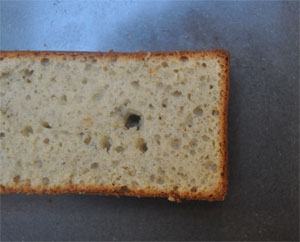
Gently fold the egg whites into the flour mix, then pour this into your tin.
Bake for 15 minutes until golden and a skewer / chopstick comes out clean.
Leave to cool, then trim off the top so you end up with an exposed sponge. It should be 3 to 4cm in height after being cut. Flip it upside down, so the exposed sponge is on the bottom.
Remove the feuilletine layer from the fridge (still in the cling film), then put the joconde on top. Cut the feuilletine so that it matches the sponge as closely as possible - we'll be chopping the ends off later, so it's the sides that matter the most.
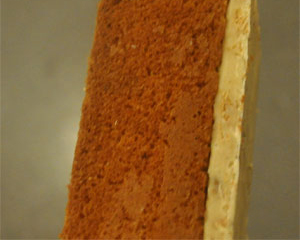 Peel off the top layer of cling then place this back in your 5cm x 30cm baking tin with the cling film layer at the bottom so it's easier to remove later (get that right or you'll end up with cling inside your cake!).
Peel off the top layer of cling then place this back in your 5cm x 30cm baking tin with the cling film layer at the bottom so it's easier to remove later (get that right or you'll end up with cling inside your cake!).
Place the joconde on top, cut side down onto the feuilletine. If using the vanilla vodka, brush some on top of the sponge. Put this in your freezer.
Make the black vanilla bavaroise
Weigh your milk out into a heavy bottomed pan, then split and scrape the vanilla pods to get the seeds. Add both the seeds and pods to the milk along with the extra vanilla powder.Heat until it hits boiling point, then turn off your cooker hob ring and leave to infuse for 30 minutes.
When time's nearly up, start preparing the other ingredients. Soak your gelatine in cold water and set aside.
Weigh out the white chocolate into another bowl with a fine sieve on top, and again set aside.
In a 3rd bowl, place the egg yolks and whisk them with the caster sugar until they become pale. Finally, get your thermometer ready.
Remove the pods from the milk, then put over a medium heat until boiling again. Carefully temper the egg yolks by pouring a little milk over them while whisking. Continue to add more until all the milk has been combined with the yolks.
Pour this back into the pan and keep stirring with a wooden spoon. Read the temperature - raise it until the thermometer reads 82 degrees C then immediately pour through the sieve onto the chocolate. Let this sit for a few minutes, then squeeze out the gelatine and add to the mix. Use a stick blender to blend everything to ensure it's totally smooth.
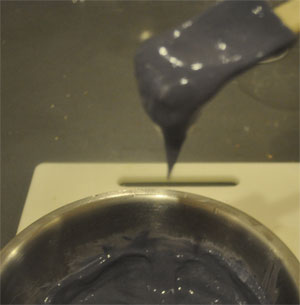 Start adding the black food colouring - my one turned out purple-ish (using Americolor powder) but that's probably because I didn't want to overdo it. Go as hard as you like.
Start adding the black food colouring - my one turned out purple-ish (using Americolor powder) but that's probably because I didn't want to overdo it. Go as hard as you like.
When you're happy it's all blended, pass through a sieve once more into a clean bowl and set aside in the freezer for 10 minutes to firm up.
Remove from the freezer, and whip the cream until quite thick - enough to hold its shape for a few seconds if you drop some from a spoon. Fold the cream into the custard, and return to the freezer for another 10 minutes.
After time's up, the bavaroise should be quite thick - dropping consistency as shown to the right. If it's not thick enough, freeze for a bit longer.
If you're happy, pour it over the joconde to about 1cm in height (you'll have some left over for the top) and tap the frame to level it out. Place back in the freezer to completely firm up (at least an hour). Put the remaining bavaroise in a piping bag with a 1cm nozzle and reserve in the fridge.
Make the white vanilla bavaroise
This is the same method as above, but wait until the black layer has set before you start. While it may seem like a lot, you'll need it to cover everything.Weigh your milk out into a heavy bottomed pan, then split and scrape the vanilla pods to get the seeds. Add both the seeds and pods to the milk. No extra powder in this one.
Heat until it hits boiling point, then turn off your cooker hob ring and leave to infuse for 30 minutes.
When time's nearly up, start preparing the other ingredients. Soak your gelatine in cold water and set aside.
Weigh out the white chocolate into another bowl with a fine sieve on top, and again set aside.
In a 3rd bowl, place the egg yolks and whisk them with the caster sugar until they become pale. Finally, get your thermometer ready.
Remove the pods from the milk, then put over a medium heat until boiling again. Carefully temper the egg yolks by pouring a little milk over them while whisking. Continue to add more until all the milk has been combined with the yolks.
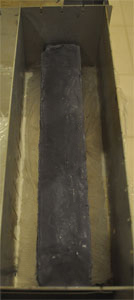 Pour this back into the pan and keep stirring with a wooden spoon. Read the temperature - raise it until the thermometer reads 82 degrees C then immediately pour through the sieve onto the chocolate. Let this sit for a few minutes, then squeeze out the gelatine and add to the mix. Use a stick blender to blend everything to ensure it's totally smooth.
Pour this back into the pan and keep stirring with a wooden spoon. Read the temperature - raise it until the thermometer reads 82 degrees C then immediately pour through the sieve onto the chocolate. Let this sit for a few minutes, then squeeze out the gelatine and add to the mix. Use a stick blender to blend everything to ensure it's totally smooth.
When you're happy it's all blended, pass through a sieve once more into a clean bowl and set aside in the freezer for 10 minutes to firm up.
Remove from the freezer, and whip the cream until quite thick - enough to hold its shape for a few seconds if you drop some from a spoon. Fold the cream into the custard, and return to the freezer for another 10 minutes.
After time's up, the bavaroise should be quite thick - dropping consistency as shown in the image of the black bavaroise above. If it's not thick enough, freeze for a bit longer.
Next, if using the Silverwood cake tin, change the notches so you have 3 showing (i.e. 4 lanes wide). Move the frozen 3-layer cake to the centre as best you can (we'll trim it later anyway). Otherwise, put your frozen cake in the larger of your two tins. Line the sides of the tin with greaseproof paper, cling or acetate.
Pour the mix over the frozen cake, making sure it goes down each side, and tap the frame to level it out. Place back in the freezer to completely firm up (at least 2 hours this time).
Spray
Put the chocolate, cocoa butter and superwhite (if using) in a heatproof bowl and place over a simmering pot of water.When everything looks completely melted, blend with your stick blender just in case then pour into your spray gun.
Take out a big box - a 12-hole wine box is a good size, or one for 12" vinyl records (a sentence which sums up our household quite neatly) - and cut off top flap. Lay it down so you have flaps on the left, bottom and right. Place a chopping board in the box, then put a layer of greaseproof paper on top.
Remove the cake from the freezer. At this point, we need to cut the cake in half. You're welcome to keep it whole, but I found this to be much easier to spray.
If the sides are a bit wonky (mine were, as I'd used cling film and didn't get the cake dead-centre) use a very sharp knife to cut thin slides from each side to level things up.
If necessary, you can also use a blowtorch to slightly melt (heat for no more than 1/2 second) any side that isn't perfectly smooth. Once heated, use a right-angled spatula to smoothen. It should re-freeze within a couple of seconds.
If you're ready to spray, put your first cake in the box and turn on the gun. When flocking, I normally rotate the cake 3 times to make sure it has built up enough.
Repeat with the other cake, then return to the freezer to harden.
If you like, any remaining chocolate can be spread on a silicone mat to harden up. You can then use shards of it to decorate the cake later.
Make the tuiles (optional)
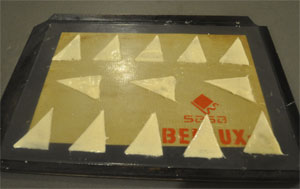 Pre-heat your oven to 170°C.
Pre-heat your oven to 170°C.
Heat the butter in a pot, then remove from the hob and let it cool a little.
Place the egg whites and caster sugar in a bowl and whisk until combined. Add the vanilla powder and whisk again. Finally, sieve in the flour, and whisk until you get a paste. Pour in the cooled butter and make one final whisk to combine.
Place a silicone baking mat on a heavy tray.
If you've got a tuile pattern mould, put it over the silicone mat. I don't - so I've made a triangle one by cutting one out of a piece of acetate.
Spoon a small amount of batter onto the mould or template, then use a pallete knife to smothen. They should be around 2mm thick. If you don't have a mould or template, just spoon some onto the mat and make a circle with the back of the spoon. Sprinkle each one with a small amount of fleur de sel.
Place in the oven for 7 minutes.
Get a rolling pin ready to bend the tuiles - or in my case, I had one of those U-shaped moulds. These produce a really good bend. In either case, remove the tray from the oven, and use a palette knife to release the tuiles. Place them carefully over the pin or in the U-shaped mould - the first ones will be quite pliable, but as you reach the end of the tray you might find them becoming brittle. Try to work as quickly as you can.
Leave to cool.
Make the fluid gel (optional)
Weigh the soda, sugar, vanilla powder and agar agar into a heavy bottomed pot. Heat until it boils, while whisking constantly.When it hits boiling point, remove from the heat and pour into a bowl. Leave it to cool slightly, then add the vodka.
It will set after around 30 minutes at room temperature. To make the gel, simply remove the set jelly, chop it and throw it in your blender for 5 minutes. The agar structure will break down, but remain viscous.
Slide into a piping bag with a 1/4cm nozzle.
Plating up
Take the sprayed cakes out of the freezer. On the first cake, using a sharp knife, slice off each end so that it exposes the layers within again.Pipe dots of the black custard in random sizes on top, followed by dots of fluid gel. Add one of the salted tuiles, sticking it into the cake gently. Crumble over some feuilletine, dust a tiny bit of vanilla powder over the top and add a few crystals of fleur de sel. Finally add your chocolate shards, if using.
Repeat with the second cake.
At this point you'll want to let it defrost a bit more at room temperature - due to everything being really soft, it won't take long. If your house is reasonably warm, it'll be done in 30 mins to an hour.
When you slice it, blowtorch or otherwise heat your knife firsts. Cut quite thin slices - about 1cm thick.
Enjoy all your hard work. Or, if it has all gone wrong, pop down to LPDR and buy a Grand Cru Vanille. It might just change your life.









